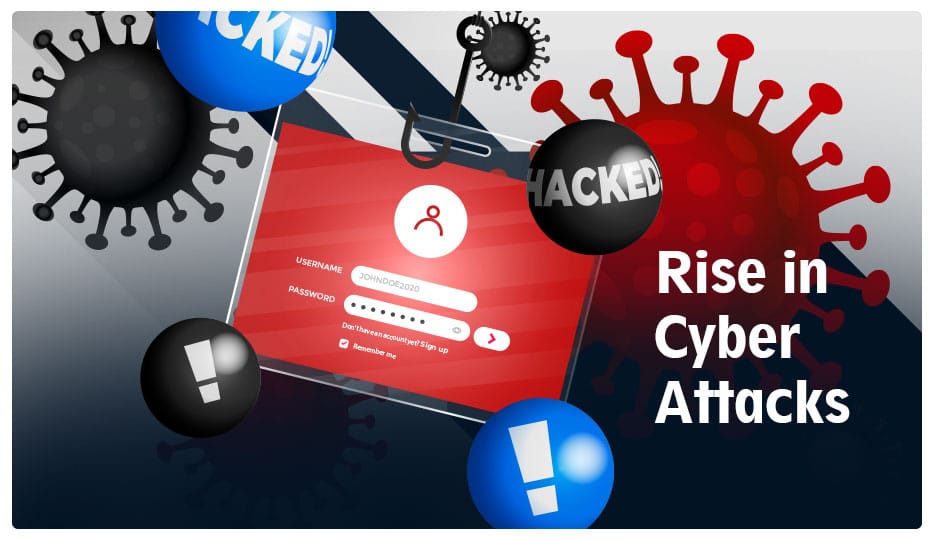
Cyber Attack Cases Grow at A Worrisome Rate During the Pandemic
The fight against the COVID-19 pandemic has been very taxing and is likely going to continue for quite a while. Businesses seem to have stopped fretting the inevitable and have accepted that WFH is going to continue for some time. Work timings may not be as strict as they would be in the office. And in some cases, deadlines have eased down to cope with the constant tension of the coronavirus. However, the lax in other work policies have also brought with them the threat of relaxation of security policies. Remote working brings with it a host of security concerns that are unlike cyber threats in the workplace. Collaboration is an entirely new ballgame. While employees have already worked remotely from time to time, being forced into it is different than opting for it. Amidst this confusion and transition, cyber attack cases are on the rise. The pandemic seems to have brought with it not just the one COVID-19 virus.
Check Point Report on Cyber Attack Cases
A majority of the organizations have faced a rise in cyber threats in some form or the other. 61% of the firms surveyed by Check Point security said they had expected to feel the brunt of remote working. Only 29% of the companies interviewed reported that they did not observe a rise in cyber attack cases. Check Point surveyed a total of 411 IT companies, all of which had a strength of over 500 employees.
The Two Types of Cases Coming To Light
The attacks themselves seem to have followed a pattern. 55% of the attacks were your regular phishing attacks. But a new trend has emerged and continues, which accounts for 32% of the attacks. This is the trend of false websites claiming to give guidelines and latest news on the virus. We’ve already covered in an earlier blog on coronavirus phishing tactics, how these websites have attachments loaded with malicious payload. They tell you to download the attachment to know more about the likely hot zones and also some preventive techniques. This trick later slid into emails as well. Cyber criminals used fake emails from public health groups to either spread panic or ‘give help’ about the pandemic.
“Cybercriminals will always seek to capitalise on the latest trends to try and boost the success rate of attacks, and the coronavirus pandemic has created a perfect storm of a global news together with dramatic changes in the working practices and technologies used by organizations.” – Rafi Kretchmer, Check Point’s Head of Product Marketing
A possible reason for this rise in cyber attack cases might be the increased attack surface. Kretchmer says it has become vital for companies to opt for security services that provide end-to-end protection.
Besides email hacking and fake websites, Check Point also observed a notable increase in Zoom domain attacks. The collaboration software got either trolled, or sold on the dark web.
Right Choices Can Save You
Security, as always, lies in your hands. There are things you can do that will prevent you from becoming a statistic of cyber attack cases. We have potent guidelines for you, which we have provided in our blog on WFH Safety Precautions. Besides, we offer tools and services that will shift the responsibility of security from your tensed shoulders to ours.
FortiClient offers lockdown visibility and control of your software and hardware inventory across the entire security fabric. IF security breaches occur during WFH explosion, it can be difficult to pinpoint the weak link in the network. With FortiClient you can identify vulnerable or compromised hosts. Also, you can track all details of the systems and user profiles across your attack surface.
FortiClient’s Security Fabric Integration, ensures that all fabric components – FortiGate, FortiAnalyzer, EMS, Managed AP, Managed Switches, Sandbox – have a unified view of endpoints in order to provide tracking & awareness, compliance enforcement and reporting, no matter the physical location of your end-node.
Email is the most important business communication tool and the leading attack vector for security breaches. Cisco’s Email Cybersecurity Report found that attackers still turn to email as the primary vector for spreading malware. Cisco Email Security includes advanced threat defense capabilities that detect, block, and remediate threats in incoming email faster. Simultaneously, it protects an organization’s brand, prevents data loss, and secures important information in transit with end-to-end encryption.
To know more about this product or acquire it for your organization, simply write to us at sales@logixstaging.learnedstudio.com. We will get back to you within no time.